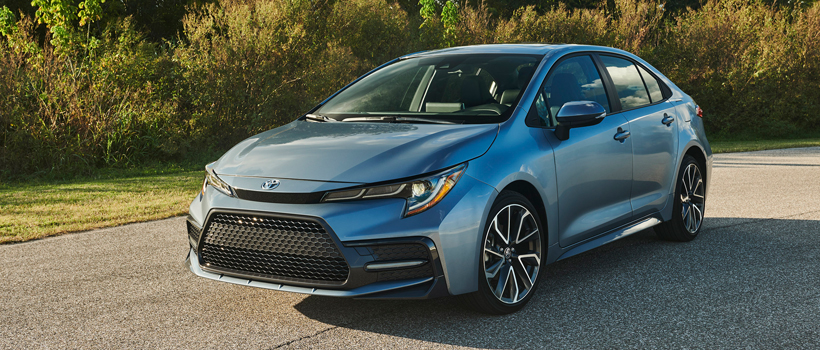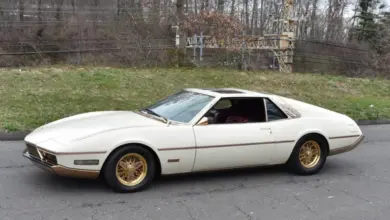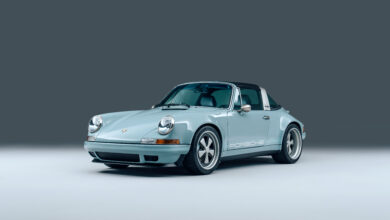Toyota Debuts 12th Generation Corolla

The 12th-generation Toyota Corolla sedan has arrived. The Corolla hatchback, introduced earlier this year, and the new sedan are both are based on the Toyota New Global Architecture (TNGA), which is far more than a new body structure, bringing together new approaches to engineering, design, assembly, and materials, according to Toyota.
The Corolla sedan’s bold new look reflects a bumper-to-bumper, wheels-to-roof transformation for the model.
The 2020 Corolla will be available at dealerships this spring.
Design Transformation
From every angle, the new Corolla sedan looks lower and leaner, tauter and tighter, according to Toyota. Powerful fender flares and curved fender-top surfaces accent its sculpted, athletic core.
The design team called its working concept “shooting robust,” because they were shooting for a robust, confidence-inspiring stance. Yet, they had to maintain ample space for practical, real-world use.
The 2020 Corolla sedan rides on a 106.3-inch wheelbase, like its predecessor, yet any commonality ends there. Corolla sedan’s performance and stance benefit from wider front (by 0.47 inch) and rear (by 0.87 inch) track dimensions. The front overhang was shortened by 1.3 inches, and the rear overhang extended by more than a half inch. Height was reduced by 0.8 inch, and the hood lowered 1.4 inches for better forward visibility, made possible by mounting the engine lower. Those changes, plus many others, reduce the center of gravity by 0.39 inch.
The bold front fascia details vary by model grade, with the SE and XSE putting on the sportiest face, including a body-color chin spoiler and aero stabilizing fins to emphasize the wide stance, according to Toyota. The slim, J-shaped Bi-Beam LED headlamps wrap deeply into the front fenders. The sporty SE and XSE grades use triple J-shaped clearance lamps with LED light guides along with LED turn signals, creating a unique design signature.
The available Adaptive Front-lighting System (AFS) provides a wider field of light and steers the low beam in the direction of the turn, based on steering angle and vehicle speed.
The rear leaves a distinct lighting impression as well, with narrow combination lamps that wrap deeply into the fenders. All 2020 Corolla sedan models use LEDs, the type and style varying by model grade. The sporty grades feature smoked outer light lenses.
The new Corolla is available in Celestite Grey Metallic, Blizzard Pearl, Super White, Classic Silver Metallic, Black Sand Pearl, Barcelona Red, Blue Crush Metallic and Blueprint.
Wheels
The Corolla sedan transformation continues where the rubber meets the road. For the first time, 18-inch wheels are on the menu, standard on the SE and XSE grades. These multi-spoke alloys get their looks from a complex machining technique paired with deep surfacing and dark accents. The LE grade rides on 16-inch steel wheels with covers. The XLE grade gets new 16-inch alloy wheels with 3D-twisted spokes.
Cabin Fever
The Corolla interior Toyota describes as sensuous minimalism. It’s equal parts sporty and elegant, and, as always, Corolla-comfortable and durable, according to the company.
“A neat instrument panel lends an open, harmonious feeling thanks to its slimmer upper surface, with character lines that interlock with the door trim to convey an airy atmosphere,” according to Toyota. “At the center of the instrument panel, within easy view for the driver and front passenger, sits a high-resolution 8-inch multimedia touchscreen for the standard Entune 3.0 multimedia system on all grades except the L grade, which gets a 7-inch multimedia touchscreen.”
The center stack screen provides access to vehicle settings, audio controls, navigation, and Entune 3.0 apps. Climate controls, located below the multimedia portal, are fashioned in a bright, highly visible digitized configuration. The center stack flows into a wider console, with an armrest that’s nearly 0.8-inch longer than in the previous model, for greater comfort.
Compared to the previous Corolla sedan, the instrument panel, cowl, hood and beltline height are all lowered to increase visibility and create the interior’s open feel. High-gloss materials are paired with matte elements; silver accents with piano black and available contrasting stitching.
Available ambient lighting illuminates the front door trim, console tray and front cupholder. The tray can hold small items such as a smartphone or wallet, or, when so equipped, houses the optional Qi wireless device charging pad. Terraced cup holders adapt to various-sized beverage containers.
Digital Tools
The Corolla sedan comes standard with a 4.2-inch thin film transistor (TFT) Multi-Information Display (MID), with an available 7-inch MID located between the high-grade tachometer and speedometer. With the larger display, the driver can switch between analog and digital speedometer styles.
Featuring rich graphics, the easy-to-read MID can be custom configured by the driver and offers intuitive operation to access information for the audio and multimedia systems, navigation system, vehicle information including fuel efficiency and tire pressure, the Dynamic Radar Cruise Control (DRCC), and other important parameters and system settings.
Front Row Seating
From behind the wheel, the 2020 Corolla sedan feels quite different than its predecessor, according to Toyota. Positioning the driver’s hip point 0.98-inch lower and 1.57-inches further rearward yields an optimized driving position.
These changes, along with the reconfigured lower beltline, slimmer instrument panel, slimmer A-pillars, and repositioned side view mirrors, result in more expansive outward visibility, according to Toyota.
The front seats of the XSE and SE grades debut a new design featuring a unique shape with a headrest that nestles into the shoulder area, while the XLE and LE grades offer a seatback with a new U-shaped pattern. The SE and XSE grades’ front seats offer thin, yet broad shoulder supports, evocative of a competition bucket seat, which overlap solid and thick side bolsters to achieve enhanced holding performance, according to Toyota.
Seating materials include standard cloth or, in higher grades, SofTex. New interior color schemes include several striking two-tone accents. Choices include blue/black (black as the main color with blue highlights), Moonstone (light gray as the main color with dark gray highlights) and new Macadamia (a warm, inviting cream color).
Silent Ride
The rear seat area in the new Corolla retains excellent headroom, despite the lower roofline, according to Toyota. Legroom is also plentiful, fulfilling a basic mission of sedans.
What is not present in the 2020 Corolla sedan is noise, according to Toyota. Powertrain and road noise have been culled thanks to revised drivetrain efficiencies, plus the widespread implementation of sound-absorbing materials, including Thinsulate, sealants, foams, and silencers.
Multi-Choice Multimedia
The 2020 Corolla sedan comes ready to pair with the driver’s digital life. The standard Entune 3.0 Audio includes an available 8-inch touchscreen display; six speakers; Apple CarPlay compatibility; Amazon Alexa; Entune 3.0 App Suite Connect; Safety Connect; Wi-Fi Connect; Scout GPS Link Compatible; Siri Eyes Free; auxiliary audio jack and USB 2.0 port with iPod connectivity and control; AM/FM; MP3/WMA playback capability; hands-free phone capability; voice recognition and music streaming via Bluetooth; customizable home screen; and weather/traffic info via Entune 3.0 App Suite. The LE and SE grades get Entune 3.0 Audio with an 8-inch touch screen and 2 USB ports.
Entune 3.0 Audio Plus, standard on XSE, XLE and optional on SE CVT, adds an HD Radio and Weather/Traffic info; SiriusXM with Cache Radio; Entune 3.0 Connected Services; Service Connect, and Remote Connect.
Also available on the SE CVT is Entune 3.0 Audio Plus with JBL.
Topping the range is Entune 3.0 Audio Premium that’s optional on XSE and XLE. The package includes a JBL nine-speaker, 800-watt system with Clari-Fi; Dynamic Voice Recognition; Dynamic Navigation; Dynamic Points of Interest Search; and Destination Assist Connect.
JBL Audio system highlights include:
- Next-Generation HID8 amplifier creates 800-watts of total power
- Free-standing horn tweeters located in the A-pillar at ear level for optimal high-frequency performance
- 6.7-inch door subwoofers for powerful deep-bass response
- Sealed inner door panels promote cleaner, more powerful bass
- Midrange speakers provide full-range sound for rear passengers
- Clari-Fi technology analyzes, rebuilds, and restores audio signals that were lost in the digital compression process
Performance
The 2020 Corolla sedan L, LE, and XLE grades will use the 1.8-liter engine (2ZR-FAE) found in the previous generation, yet with more horsepower and better fuel efficiency, according to Toyota. The XSE and SE grades are powered by a completely-new 2.0-liter Dynamic-Force direct-injection inline four-cylinder engine (M20A-FKS).
This new engine delivers more performance while using less fuel, according to Toyota. Remarkably, the new Corolla sedan engine is physically smaller and lighter, helping to lower the car’s center of gravity and improve its overall balance.
Here are some of the tech bits from Toyota on Corolla sedan’s new available engine:
- The new Dynamic Force engine gets it high power and efficiency from a combination of high compression ratio (13:1), Toyota D4-S fuel injection combining direct and secondary port injectors, high-speed combustion, VVT-iE intelligent variable valve-timing on the intake side and VVT-i on the exhaust. VVT-iE uses an electric motor instead of oil pressure to control the variable valve timing
- A two-discharge port oil pump and a variable cooling system with electric water pump help maximize engine performance and efficiency. The more efficient cooling system also ensures quicker cabin heating on cold days and quicker cool-down when the air conditioner is used
- All of those technologies, along with ultra-low internal friction, yield a maximum thermal efficiency of 40 percent, very high for a passenger vehicle engine. You can’t feel thermal efficiency, but you can feel the effects of 169 peak horsepower at 6,600 rpm and 151 lb.-ft peak torque at 4,800 rpm.
Shifting Smarter
Sedan buyer trends are shifting, and the 2020 Corolla sedan is right there with them, according to Toyota. The new Dynamic-Shift CVT (continuously variable transmission) combines the smooth, fuel-efficient performance of a CVT with a more direct driving feel of a traditional geared automatic. The key to its distinct performance feel is a physical first gear used for start-off acceleration, before handing off to the CVT’s pulley system.
Because the launch gear is handling the higher input load at launch, the size of the CVT’s belt and pulley components could be reduced, yielding shifting speeds that are 20 percent faster than in a conventional CVT.
High-speed, high-response gear-shifting technology, using a multiplate wet clutch, switches power from the gearset to the CVT’s belt and pulleys. The Direct Shift CVT has simulated 10-speed Sequential Shiftmatic steps along with Sport Mode. Synchronization of the increasing engine revs and vehicle speed gives a linear acceleration feel.
For those who want to shift for themselves, the 2020 Corolla sedan offers an all-new 6-speed iMT (intelligent manual transmission). Like some premium sports cars, it features downshift rev-matching control, automatically detecting when the driver is shifting and quickly rev-matching to make any driver a stick-shift pro.
Suspension
The MacPherson strut front suspension, totally revised for the new Corolla sedan, uses sophisticated techniques, including a strut bearing mounted coaxially with the kingpin axis, according to Toyota. This feature allows smoother upward suspension travel, especially while traversing bumps, resulting in more comfortable steering feel.
Overall, front and rear suspension friction has been reduced by 40 percent. Newly developed shock absorbers have been tuned to provide optimal damping force for dynamic handling and stability with exemplary ride comfort.
Safety
The 2020 Corolla sedan features eight standard airbags and Toyota’s Star Safety System, which includes Enhanced Vehicle Stability Control, Traction Control, Electronic Brake-force Distribution, Brake Assist, Anti-lock Braking System, and Smart Stop Technology. All Corolla sedan models come equipped with a standard backup camera.
Blind Spot Monitor is a standard or optional feature, depending on model grade. When an approaching vehicle is detected, the system is designed to alert the driver using indicators on the outside mirrors.
Brake Hold, when engaged, is a technology that helps reduces driver workload while waiting at a traffic light or while driving in traffic. When the driver depresses the accelerator pedal, Brake Hold releases.
All safety features, according to Toyota, include:
- Toyota Safety Sense 2.0-Advanced suite of integrated active and pre-collision safety features.
- PCS (Pre-Collision System): Uses both a millimeter wave radar sensor and a forward-facing camera sensor for highly accurate detection of objects such as a vehicle or pedestrian or bicyclist in front of the vehicle. If the PCS determines there is a high probability of a collision, or if it deems a collision is unavoidable, the system is designed to automatically activate the brakes to help avoid the collision entirely or mitigate the impact force.
- DRCC (Dynamic Radar Cruise Control)-Designed for highway use; has a vehicle-to-vehicle distance control mode that utilizes a millimeter wave radar sensor and camera sensor to maintain a pre-set follow distance from the preceding vehicle. The full-speed DRCC version, standard on CVT models, is also capable of low-speed following, including stop-and-go traffic. The Corolla sedan is designed to stop when the vehicle ahead comes to a stop, maintaining an appropriate distance to it.
- LDA (Lane Departure Alert) with Steer Assist: Provides the driver with audible and visual warnings (vehicle positioning warning image shown in the Multi-Information Display) and, if necessary, is designed to provide steering assistance if it determines the possibility of deviation from the driving lane. It is also designed to detect vehicle sway (excess weaving within the driving lane) that might indicate driver distraction, inattention or drowsiness.
- LTA (Lane Tracing Assist): LTA, available on CVT-equipped models, is enabled when LDA and DRCC are both on and active. LTA employs a lane centering function that is designed to make constant steering inputs to help the driver keep the vehicle in the center of its lane. LTA is designed for uses on relatively straight highways to preemptively avoid unwanted lane departures and reduce driver fatigue.
- AHB (Automatic High Beams): When enabled, the AHB system uses an in-vehicle camera to help detect the headlights of oncoming vehicles and taillights of preceding vehicles, then automatically switches between high and low beams as appropriate.
- RSA (Road Sign Assist): Designed to recognize speed limit, Stop, Yield, and Do Not Enter signs and displays them on the vehicles MID to help assist the driver.



